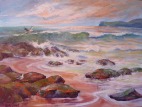


Hello All!
Welcome to this post about all things watery in artwork – aquatic life, seascapes, freshwater inspirations and beach paintings. I will begin with records I have of my own artwork and invite you to add yours…then finish with some tutorials towards the end of the Post.
First some artworks inspired by aquatic life, much of which I was lucky to be exposed to a marine environment for 20 year, living at MacMasters Beach. My husband John was a keen Naturalist, Diver and Aquarist so our home was full of salt water aquariums which housed a wide range of amazing tropical marine fish…along with seahorses, invertibrates and even at times a wobbegong shark, sea snake and blue ringed octopus!
The only major problem was once when a sea snake escaped out of the tank into the living room and they are very venemous! John came home to find myself and the kids all on the front lawn and no dinner ready! He quickly located the snake under a beanbag seat and took it down to the sea to let go. We had only had it in the tank for a short period to provide it with some peace and safety while it sloughed its skin and this was now complete. Here is a picture of the actual sea snake.

and here is my painting of John cleaning a fish catch at MacMasters Beach.
I also enjoyed painting some of the tropical marine fish we cared for in the aquariums as under…
The beautiful watery environment of the NSW Central Coast where we live, inspired me to create many paintings over the years and still does…from close-ups of rockpools to expansive views.
In summer the beaches are very popular with people enjoying the sun, sand and sea. Since I like figure drawing, there was plenty of reference for painting!
On the Brisbane Waters inlet from Broken Bay, I found endless wonderful subjects to paint too – like this one of Hardy’s Bay wharf.
and this one inspired by moored boats at Davistown.
Then there is the wonderful aquatic birdlife to paint.
and other watery wildlife…
We lived so close to the ocean that the house shook when waves dumped onto the sand. I became very aware of the effect of the moon on the sea and the tidal patterns. This painting, I called “Moonpower”.
Now for some insights into painting seascapes. In painting this soft study below, I have included the tonal plan for the painting and the colour palette used.
I would now like to share with you my method in painting this seascape of North Avoca Beach below, first is the thinly washed in underpainting in acrylics diluted with water, which lays out the composition and beginnings of the colour scheme. I had at this stage planned to put a person sitting on the rocks at the left…

While the underpainting dried (which is quite fast in acrylic paints) I mixed plenty of nice juicy paint in the colour scheme planned, picked up my painting knife (shaped like a small trowel with a raised handle) and built up the painting with texture. I just love the feeling of laying on paint this way and feeling the thick buttery texture. I added a little modelling compound to the acrylics to give them more body and didn’t dilute the mix by adding water at all. I worked the sky, headland and distant sea first, then moved to the rocks. Once that was dry, I then added the waves and all white areas. If I had tried to add this before the rock colours were dry, I would have muddied the whites. The idea for a figure sitting on the rocks was discarded in favour of the free wild touch by adding the seagulls instead. Here are a couple of close ups of sections of the painting…
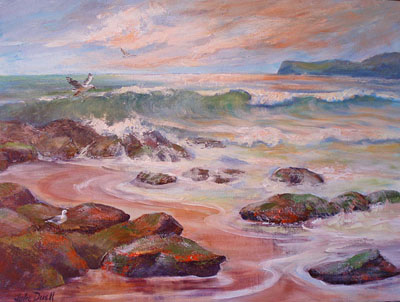
I hope this may be of help to someone in planning a method of approach in seascapes. Painting knives take a bit of getting used to but are so satisfying once you can manage them. I learned painting knive techniques by using up any leftover paint and doing small textural experiments in a pad. I find almost everyone really loves to see and feel texture in paints – I guess it’s because there is absolutely no doubt it is ORIGINAL and not a copy!
Here are some close-ups of the texture…


Here another painting (of Tallow Beach) where I used painting knife texture with thick paint. It gives a very realistic solid look to the rocks in particular.

If painting knife techniques are not for you, there are other ways to achieve texture by the use of collage…e.g. in the painting below (entitled “Moonrider”) I used tracing paper crushed, glued and applied to the board with my fingers, coaxing the creases to follow the form of the waves. I then mopped up the excess PVA wood glue with a rag, laid a sheet of paper over and rolled firmly with a rolling pin to form the tiny creases. Once totally dry, I painted into the finished texture. Some people use tissue paper but I find it a bit flimsy and prefer a tougher tracing paper, but it’s worth experimenting. You could also use an acrylic texture or modelling paste and roll over crumpled gladwrap to get interesting textures similar to this…carefully removing the gladwrap before allowing to dry.

The above painting was for my son, Scott’s birthday close to 20 years ago. It is framed behind glass and has stood the test of time, looking just as permanent and vibrant as when it was first painted.
Below is a demonstration painting using acrylics and actual beach sand collage. The rock textures were applied with a sponge and the shadows of the rocks were painted first in acrylic. Once all paint was dry, I then applied PVA white wood glue to all the sand area, sprinkled on the dry sand, tapped off the excess and allowed to dry. Much to my surprise, the underpainted shadows of the rocks showed softly through the transparent glassy sand grains!

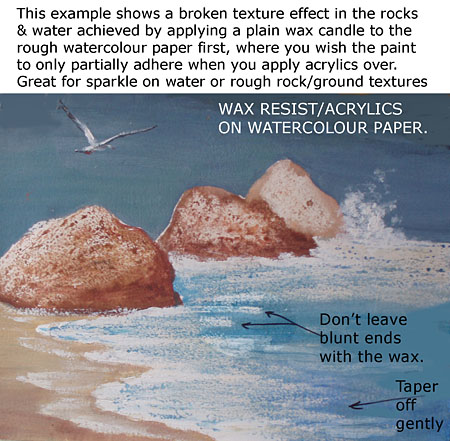
This next painting is in the complementary colour range from RED-ORANGE to BLUE-GREEN “Sunrise over MacMasters Beach”. To see this and more colour ranges based on opposites on the colour wheel, go to the Post on COLOUR MIXING.


Good luck and happy painting everyone! Don’t forget you can email me if you have questions or leave comments below.
Cheerio for now,
Julie jduell@pnvr.com.au

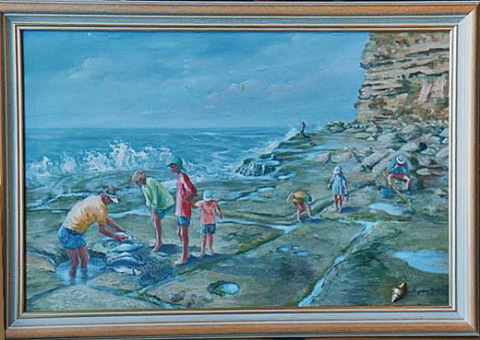








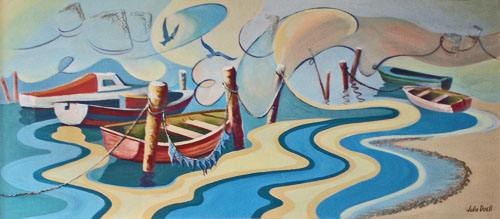









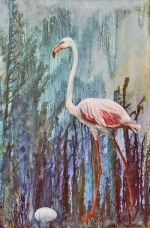







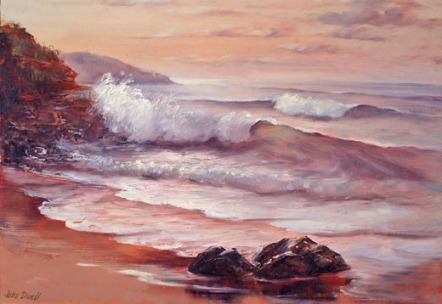
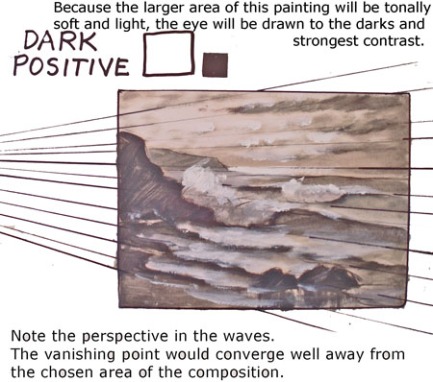
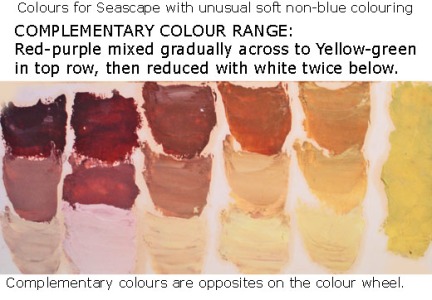
I Would Want To Learn. How To Paint A Backgroud And Using Of Brush With Poster Colour.
By: krrish on August 26, 2016
at 7:40 am
Thank you for your message Krrish. Brushwork is learned best by experimenting – nobody taught me how so that is how I learned. Enjoy trying out different brushes and thicknesses of paint and you will learn.
By: Julie Duell on August 26, 2016
at 8:16 am
I am a begain acrilic art enthusists.At age 74 bur seem to have some abilities to draw most anything I see but small details of doing a realist beach with so much going on. I was amazed with idea of applying glue and sprinkling sand on the canvas. my question is if am doing a beach with a dog that consumes 80 % of the campus with no horizon will that effect over power the subject be cause the picture of the puppy.is looking downward and nothing but sand in view
By: Allen Johnson on February 17, 2016
at 3:33 pm
Thank you for your message Allen. I suggest you try the sand glued onto a test board applying it over different colours (most sand being transparent, the under-colour comes through). Then you will know if it is suitable for your painting. I discovered the effect by trial and error, just experimenting. The texture may or may not be what you want. Happy discoveries.
By: Julie Duell on February 18, 2016
at 10:29 am
I feel a lot more people will need to read this, really beneficial info.
By: rockwell on May 17, 2010
at 2:37 am
Greetings Julie,
I hope you remember me, though I didn’t contact you for some time.
I was working very hard on creating two blogs and I didn’t want to show up until I’m ready.
Now they are indexed by Google and searchable.
One of my blogs is about my paintings and I posted my “Rocks on the Beach” painting there, the one you know.
I also linked back to you very educative blog, I hope you don’t mind.
As painting is not a very popular subject I created my other blog with my amateur photos and I linked them together.
In the meantime I painted only one painting: the “Hollyhock” after a photo of mine.
When and if you have the time, I invite you to take a look at my other paintings on my blog and perhaps give me a constructive critique at http://maiaspaintings.blogspot.com – the blog’s name is “Maia’s Paintings”.
Regards Maria.
By: Maria on September 3, 2008
at 6:07 am
Greetings Maria!
I am happy to give permission for you to copy my painting of Tallow Beach so long as you change something to make it “yours”. In starting out we can learn a lot about techniques and effects by using other artists’ work as a guide, but ultimately we need to let go of that crutch and give our own rendition of the world around us, either painting from life or drawing on our imagination. We want to see how you, Maria, express yourself. and share how you feel about your subjects.
For instance, I wonder if you have strong leanings towards design – whether you like outlines or not – bright colours or subtle – what subjects appeal to you….etc.
Acrylics are a good way to start – you can go thick or thin and they will dry quickly. Good luck, Julie
By: Julie Duell on June 22, 2008
at 1:53 am
Dear Julie,
My name is Maria, I live in Romania (east Europe) and I am a beginner, amateur painter. I admired your beautiful paintings and enjoyed the explanations about making texture. I like very much your” Tallow Beach” the one with the rocks and the little boat at the horizon. I should like to ask your permission to paint this subject, to try at least. I shall not make the texture because I have no experience jet, but I could try an acrylic with your permission. Please let me know your decision by email if it it’s convenient for you. Many thanks in advance.
Sincerely, Maria
By: maria on June 20, 2008
at 6:04 pm